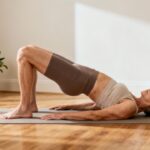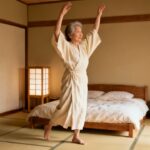Did you know that someone in the US suffers a stroke every 40 seconds? But here’s what’s truly shocking: nearly 80% of those strokes are preventable.
Not with expensive medications or extreme diets, but with simple movements you can start today in your own home—no equipment needed.
If you’re over 50, what you do today might decide whether you stay independent, active, and sharp or face a life-changing emergency.
This isn’t about fear—it’s about power. Because the right steps now could literally rewire your brain for protection.
Exercise 1: Tai Chi
What if I told you that one of the most effective exercises to prevent stroke after 50 isn’t fast-paced or physically intense, but slow, gentle, and almost meditative?
Tai Chi might look like just graceful movement, but what’s happening inside your brain while you’re doing it is incredibly powerful.
Tai Chi has been called “meditation in motion” for good reason. According to researchers from Harvard Medical School, Tai Chi helps:
- Regulate blood pressure
- Calm stress hormones like cortisol
- Stimulate deep neuroplasticity (brain’s ability to form new connections)
- Strengthen areas responsible for balance, memory, and motor control
A 2017 study from the Journal of the American Geriatric Society found that adults over 60 who practice Tai Chi three times a week significantly improved their blood vessel flexibility, reduced inflammatory markers, and boosted mental clarity.
The beauty of Tai Chi is its low impact—it doesn’t require equipment and can be done in your living room, backyard, or local park. Even better, it invites mindfulness and offers a gentle way to stay both mentally and emotionally engaged.
Exercise 2: Brisk Walking
You’ve heard walking is good for you, but did you know that brisk walking done the right way can outperform some medications in reducing stroke risk?
According to a study published in the journal Stroke, adults over 50 who walk briskly for just 150 minutes a week lowered their stroke risk by 27%.
Brisk walking increases cerebral blood flow, especially to the hippocampus and frontal lobes—areas that control memory, focus, and coordination. More oxygen and nutrient delivery to these zones means stronger, more resilient neural pathways—the exact systems that strokes attack.
Here’s what most people miss: the timing and pattern of your walks matter. Walking for 10 minutes after each meal doesn’t just burn calories; it also blunts post-meal blood sugar spikes, which are a major driver of silent vascular damage.
Exercise 3: Swimming
If you’ve ever floated in a pool and felt your joints sigh with relief, you already know swimming isn’t just exercise—it’s therapy. Swimming is one of the most effective full-body stroke prevention tools available, especially after age 50.
According to the American College of Sports Medicine, swimming improves left ventricular function—the chamber of the heart responsible for pumping oxygen-rich blood to your brain. Stronger heart yields better brain perfusion equals lower stroke risk.
Swimming also activates the parasympathetic nervous system more than most other exercises. This is the rest-and-repair part of your body that lowers blood pressure, slows heart rate, and keeps your arteries from stiffening over time.
Even if you’re not a strong swimmer, water walking or gentle pool aerobics provide many of the same advantages with added balance support from the water itself.
Exercise 4: Resistance Training
When people hear strength training, they often imagine heavy weights and gym bros. But here’s the truth: light resistance training may be one of the most powerful tools to protect your brain from stroke, especially after 50.
A 2019 study in the Journal of the American Heart Association found that adults who performed resistance training just twice a week had significantly lower risk of stroke and heart disease—even if they did no cardio at all.
Strength training does more than build muscle—it improves insulin sensitivity, reduces visceral fat, and lowers chronic inflammation—all key contributors to arterial plaque buildup.
You don’t need fancy machines or a gym membership. Simple movements like:
- Chair squats
- Wall push-ups
- Lifting soup cans
These can stimulate your muscles just as effectively. Focus on slow, steady movements with proper form.
Exercise 5: Dancing
Would you believe that dancing can protect your brain as much as your heart? It may sound too fun to be true, but science says otherwise.
According to a large study published in the American Journal of Preventive Medicine, older adults who dance regularly had a 46% lower risk of cardiovascular events, including stroke.
Unlike traditional workouts, dancing trains both your body and your brain at the same time. Dancing activates multiple areas of the brain at once—memory, coordination, rhythm, and emotion.
This multi-sensory stimulation increases the production of BDNF, brain-derived neurotrophic factor, a key protein that strengthens brain cells and promotes neuroplasticity—your brain’s ability to adapt and recover after damage.
Whether it’s ballroom, line dancing, or simply moving to your favorite oldies in the kitchen, the form doesn’t matter. What matters is that you move, smile, and enjoy it.
Bonus Tip: Morning Movement Multiplies Protection
Here’s something most doctors don’t mention: the timing of your exercise matters almost as much as the exercise itself.
According to a study in the European Journal of Preventive Cardiology, adults who exercised in the morning, especially between 7:00 a.m. and 10:00 a.m., had better blood pressure control and improved vascular function throughout the day.
Morning movement jumpstarts circulation, lowers cortisol, and helps stabilize blood sugar from your first meal onward. Even a 10-minute morning routine—walking, stretching, or dancing—can set the tone for your heart and brain.
Your Health Is in Motion—One Step at a Time
Let’s quickly recap:
- Tai Chi restores brain balance and lowers stress
- Brisk walking boosts blood flow and stabilizes blood sugar
- Swimming strengthens your heart without stressing your joints
- Resistance training builds muscle and protects your arteries
- Dancing lights up your brain and lifts your mood
- Morning exercise provides even greater protection
The truth is, you don’t need to overhaul your life. You just need to start. Even doing one or two of these activities consistently can reshape how your brain ages, how your heart beats, and how your blood flows, especially after 50.
Stroke prevention isn’t about fear—it’s about freedom. The freedom to walk confidently, to remember clearly, to laugh, play, and stay active with the people you love.
Your journey to better health starts with that first step, that first movement, that first choice to protect the amazing brain and body you have.








